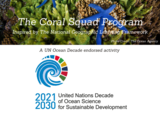
Environmental Education: Coral Ecosystems
- Subject:
- Ecology
- Oceanography
- Material Type:
- Interactive
- Lesson Plan
- Reading
- Teaching/Learning Strategy
- Unit of Study
- Author:
- Danielle Zélin
- Date Added:
- 01/26/2023

Environmental Education: Coral Ecosystems
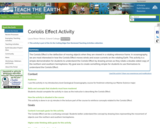
The Coriolis Effect is the deflection of moving objects when they are viewed in a rotating reference frame. In oceanography, we are most interested in how the Coriolis Effect moves winds and ocean currents on the rotating Earth. This activity is a simple demonstration for students to understand the Coriolis Effect by drawing arrows as they rotate a double-sided copy of the northern and southern hemispheres. My goal was to create something simple for students to use themselves to understand the Coriolis Effect.

In this hands-on OLogy activity, kids learn about coral reefs by building a diorama. Students are introduced to coral polyps and reefs and given illustrated, step-by-step directions that show how to construct a diorama containing models of a brain coral, a sea fan, a sponge, and sea anemones.
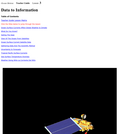
This lesson incorporates sea surface data collected by NASA satellites. Data for three surface characteristics- height, temperature and speed- are used for several activities. Students examine the differences in speed of currents relative to distance from the Equator. Sea surface data anomalies are charted and further analyzed. In addition, surface current data is presented to examine patterns related to El Niño. Note that this is lesson three of five on the Ocean Motion website. Each lesson investigates ocean surface circulation using satellite and model data and can be done independently. See Related URL's for links to the Ocean Motion Website that provide science background information, data resources, teacher material, student guides and a lesson matrix.

View the video ̢ĺŰĺĎTrash on the Spin Cycle̢ĺŰĺ to discover what causes huge quantities of garbage to end up on the most remote islands in the world and how this garbage affects wildlife.
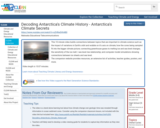
This 10 minute video builds connections between topics that are important in climate science such as: the impact of variations in Earth's orbit and wobble on it's axis on climate; how the cores being sampled fit into the bigger climate picture; connecting greenhouse gases to melting ice and sea level changes; the sensitivity of the ice melt / sea level rise relationship; and computer model simulations showing connections between ice sheets and sea level.
The companion website provides resources, an extensive list of activities, teacher guides, posters, and more.
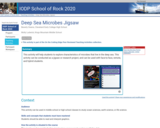
This activity will help students to explore characteristics of microbes that live in the deep sea. This activity can be conducted as a jigsaw or research project, and can be used with face-to-face, remote, and hybrid students.
Provenance: Beverly Owens, Cleveland Early College High School
Reuse: This item is offered under a Creative Commons Attribution-NonCommercial-ShareAlike license http://creativecommons.org/licenses/by-nc-sa/3.0/ You may reuse this item for non-commercial purposes as long as you provide attribution and offer any derivative works under a similar license.
(Note: this resource was added to OER Commons as part of a batch upload of over 2,200 records. If you notice an issue with the quality of the metadata, please let us know by using the 'report' button and we will flag it for consideration.)
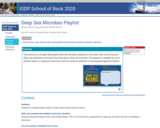
This activity is a Google Slide playlist that will introduce students to microbes that can be found in deep sea sediments, and what roles they play in their environment. This playlist is suitable for use in remote, hybrid, or in-person instruction and can easily be added to a Learning Management System.
Provenance: Molly Ludwick, Kings Mountain Middle School
Reuse: This item is offered under a Creative Commons Attribution-NonCommercial-ShareAlike license http://creativecommons.org/licenses/by-nc-sa/3.0/ You may reuse this item for non-commercial purposes as long as you provide attribution and offer any derivative works under a similar license.
(Note: this resource was added to OER Commons as part of a batch upload of over 2,200 records. If you notice an issue with the quality of the metadata, please let us know by using the 'report' button and we will flag it for consideration.)
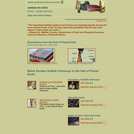
This online gallery of photos, illustrations, and videos provides a snapshot of deep sea vents and the ancient forms of life that can be found within them. Transcripts of the videos are provided, and the photos and illustrations are accompanied by explanatory texts.

This activity is designed to introduce students to the way in which thermohaline circulation and the biological pump influence the distribution of nutrients, oxygen, carbon, and radiocarbon in the Atlantic vs. Pacific Oceans.
(Note: this resource was added to OER Commons as part of a batch upload of over 2,200 records. If you notice an issue with the quality of the metadata, please let us know by using the 'report' button and we will flag it for consideration.)
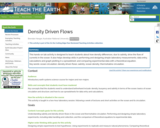
This hands-on lab activity is designed to teach students about how density differences, due to salinity, drive the flow of currents in the ocean. It also helps develop skills in performing and designing simple laboratory measurements; data entry, calculations and graph plotting in a spreadsheet; and comparing experimental data with a theoretical equation.
Key words: ocean circulation; density driven flows; salinity; ocean density; thermohaline circulation.
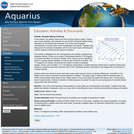
These two hands-on labs are about the role of temperature and salinity in governing the density of seawater, a major factor controlling the ocean's vertical movements and layered circulation. In the first activity students work in groups to determine the density of tap water and of tap water with salt, then compare the densities. The second activity investigates the role of temperature and salinity in determining seawater density. Students use a Temperature-Salinity (T-S) Diagram to examine the effect of mixing on density. A list of key concepts, essential questions, common preconceptions and more is included. These are part of the Aquarius Hands-on Laboratory Activities.

Water supply is a problem of worldwide concern: more than 1 billion people do not have reliable access to clean drinking water. Water is a particular problem for the developing world, but scarcity also impacts industrial societies. Water purification and desalination technology can be used to convert brackish ground water or seawater into drinking water. The challenge is to do so sustainably, with minimum cost and energy consumption, and with appropriately accessible technologies.
This subject will survey the state-of-the-art in water purification by desalination and filtration. Fundamental thermodynamic and transport processes which govern the creation of fresh water from seawater and brackish ground water will be developed. The technologies of existing desalination systems will be discussed, and factors which limit the performance or the affordability of these systems will be highlighted. Energy efficiency will be a focus. Nanofiltration and emerging technologies for desalination will be considered. A student project in desalination will involve designing a well-water purification system for a village in Haiti.

The course covers the basic techniques for evaluating the maximum forces and loads over the life of a marine structure or vehicle, so as to be able to design its basic configuration. Loads and motions of small and large structures and their short-term and long-term statistics are studied in detail and many applications are presented in class and studied in homework and laboratory sessions. Issues related to seakeeping of ships are studied in detail. The basic equations and issues of maneuvering are introduced at the end of the course. Three laboratory sessions demonstrate the phenomena studied and provide experience with experimental methods and data processing.
This course was originally offered in Course 13 (Ocean Engineering) as 13.42.

This course covers the complete cycle of designing an ocean system using computational design tools for the conceptual and preliminary design stages. Students complete the projects in teams with each student responsible for a specific subsystem. Lectures cover such topics as hydrodynamics; structures; power and thermal aspects of ocean vehicles; environment, materials, and construction for ocean use; and generation and evaluation of design alternatives. The course focuses on innovative design concepts chosen from high-speed ships, submersibles, autonomous vehicles, and floating and submerged deep-water offshore platforms. Lectures on ethics in engineering practice are included, and instruction and practice in oral and written communication is provided.
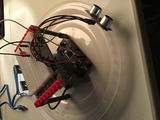
Project lesson plan involving detecting floating marine debris. Connections to the oceans' garbage patches. Resource using Micro:bit and extension equipment to wire devices and Microsoft Makecode to code the Micro:bit to perform processes. Engineering Design Process is used to design a floating platform to hold and protect all equipment from water while it performs its functions.

In this problem-based learning (PBL) activity, students take on the role of a student research scientist and explore the role of solar energy in determining climate, focusing on the urban heat island effect. Students conduct research and compare temperatures between two cities, and determine the factors that are responsible for the difference exhibited between them. The lesson is supported by teacher notes, answer key, glossary and an appendix with information about using PBL in the classroom. This is the third of three activities in Investigating the Climate System: Energy, a Balancing Act, and serves as an authentic assessment for all three modules.

This OLogy activity, a hide-and-seek game, introduces kids to the many different ecosystems in the ocean. In the Think & Link game, kids are challenged to connect all the featured organisms in three ecosystems, deep sea, coral reef, and continental shelf, by answering a series of questions.

This resource is a video abstract of a research paper created by Research Square on behalf of its authors. It provides a synopsis that's easy to understand, and can be used to introduce the topics it covers to students, researchers, and the general public. The video's transcript is also provided in full, with a portion provided below for preview:
"Biodiversity keeps our planet stable. Each species, no matter how small, plays an important role in this global balancing act. That’s why the current pace of biodiversity loss is so alarming. Unfortunately, slowing that pace is extremely difficult. Scientists must first take on the virtually impossible task of measuring the richness and variety of all life on earth—the tools for which are prone to error. Now, researchers have applied a technique that promises estimates that more closely reflect true biodiversity. Proven insightful for stony coral species found throughout the world, the approach could potentially be extended to other animals and plants. Researchers typically use two types of methods to measure biodiversity: by consulting occurrence datasets, which describe points where species have been physically counted, or by combining maps describing geographical ranges where a species is predicted to occur. Each has its own drawbacks. Occurrence datasets tend to be incomplete..."
The rest of the transcript, along with a link to the research itself, is available on the resource itself.
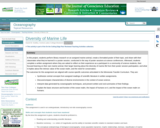
In this project, students perform library research on an assigned marine animal, create a formatted poster of their topic, and share with their classmates what they've learned in a poster session, conducted in the way of poster sessions at science conferences. Afterward, students complete a written assignment where they are asked to reflect on their experience as a participant in a community of science students, their focused learning on their own marine animal, their larger learning about the diversity of marine life from their poster session participation, and what it implies about the intrinsic value of the ocean realm, and the need for conservation.
The outcomes for this assignment are aligned with course-specific outcomes articulated in the Minnesota Transfer Curriculum. They are:
Synthesize central concepts from assigned readings of scientific literature in written assignments.
Discuss/compare characteristics of diverse environments in the context of ocean science.
Interpret data generated by oceanographic techniques, and present written and oral summaries of their findings.
Explain the basic structure and function of the ocean realm, the impact of humans on it, and the impact of the ocean realm on humans.
(Note: this resource was added to OER Commons as part of a batch upload of over 2,200 records. If you notice an issue with the quality of the metadata, please let us know by using the 'report' button and we will flag it for consideration.)